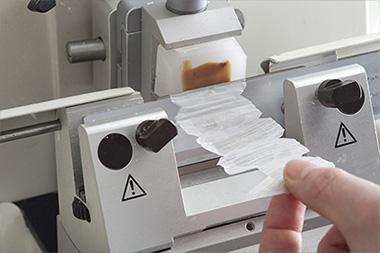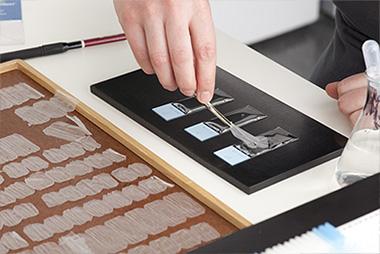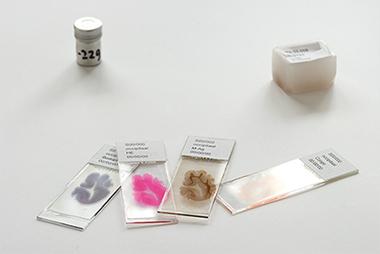Europe Leads the Way Toward Standardization and Brain Bank Networks
Quick Links
This story was updated on February 24, 2015.
No one in the field of neurodegeneration research disputes the central importance of brain banks, but that does not mean there are no complaints about them. For one, the quality of banked tissue varies widely. It depends on how soon the brain is removed after a person dies, and how scientists then handle the tissue. Because some research programs, such as those studying RNA or DNA, require well-preserved samples, neuroscientists in Europe decided to improve and harmonize protocols for processing and neuropathological diagnosis. To try to develop a gold standard, in 2001 leading European neuropathologists founded a consortium called BrainNet Europe. This organization established recommended protocols and ethical guidelines for European brain banks, although member banks are not compelled to follow them. Nineteen European banks have joined the consortium, according to Thomas Arzberger at Ludwig-Maximilian University in Munich, who manages its scientific projects.

Thin Slices.
Fixed brain sections embedded in paraffin are sliced into wafer-thin sections on a microtome. [Photo courtesy of the Netherlands Brain Bank.]
BrainNet Europe provides a single point of contact for anyone wishing to use its member banks. Researchers from around the world can request tissue online, provided their project has ethics approval. The BrainNet office forwards the request to individual banks. As is the case with nearly all banks, requesters pay processing and shipping costs. In addition to its tissue collections, BrainNet Europe maintains a database of associated clinical findings from its roughly 2,000 cases, which include neurodegenerative and psychiatric disorders as well as controls. However, access to this database is restricted to members of the consortium.
The United Kingdom maintains a national consortium as well. The UK Brain Banks Network comprises 10 banks that together store tissue from more than 10,000 brains. Member banks have adopted standard protocols for processing tissue. Researchers from around the world can search an online database and submit tissue requests. The network fulfills more than 300 requests per year, noted director Seth Love at the University of Bristol. The U.K. network also emphasizes the collection of tissue from healthy controls. It runs a longitudinal study on 3,000 volunteers, more than half of whom do not have a neurologic diagnosis. Volunteers donate their brains after death. Some of the U.K. member banks are also members of BrainNet Europe.
On the other side of the globe, in Australia, neuroscience researchers addressed the problem of finding enough tissue by forming the Australian Brain Bank Network (ABBN) in 2004. Australia has six small, regional banks that store a few hundred brains each. They were not always able to meet research requests, and shipping expenses made going overseas for samples impractical. ABBN combines the inventories of all member banks into a single online catalog of more than 2,500 brains from adult donors who had a variety of diseases. Most cases include clinical records, and a few have longitudinal data.

Slide Preparation.
A technician transfers brain sections to slides for staining. [Photo courtesy of Netherlands Brain Bank.]
As with BrainNet Europe, researchers from any country can request tissue from ABBN online. ABBN has fulfilled more than 1,000 tissue requests over the past 10 years, and sent tissue abroad to South Asian countries, said ABBN director Catriona McLean at Alfred Hospital in Melbourne. The organization also encourages future donations through its website. People willing to give their brain to research can sign up with the network; about 3,500 have done so already, McLean said.
New Initiative Provides Single Portal to U.S. Brain Banks
Until recently, the United States did not have a similar general-purpose brain-bank network (though it has been developing a rich collection of Alzheimer’s brains in particular; see Part 3 of this series). In September 2013, three institutes at NIH—the National Institute of Neurological Disorders and Stroke (NINDS), the National Institute of Mental Health (NIMH), and the National Institute of Child Health and Human Development (NICHD)—launched a joint initiative called the NeuroBioBank. This effort links together six large repositories through a common Web portal. These comprise the Harvard Brain Tissue Resource Center at McLean Hospital, Belmont, Massachusetts; the Human Brain and Spinal Fluid Resource Center at the University of California, Los Angeles; the University of Miami Brain Endowment Bank; the Mount Sinai Brain and Tissue Repository in New York City; the University of Maryland Brain and Tissue Bank, Baltimore; and the Brain Tissue Donation Program at the University of Pittsburgh. Other banks may join the collaboration, noted Michelle Freund at NIMH, who leads the effort along with Anna Taylor at NINDS.

Adding Color. A technician stains slides to reveal different pathological features. [Image courtesy of Nigel Cairns, Washington University, St. Louis.]
The NeuroBioBank project aims to improve researchers’ access to a variety of brain tissue, Freund said. Many banks specialize in one or two diseases, so in the past researchers could not always find the samples they needed from their local bank. To use the NeuroBioBank, scientists submit an online tissue request; the six centers review it and indicate whether they have materials that match. Also in 2013, the centers adopted the same protocols for collecting, processing, and storing brain samples. Clinical records associated with each sample follow a standard format and will be collated into a single database. In the year since the project began, the centers have collected 500 new brains using the standard protocols, Freund said. In the near future, these tissues will be listed in a catalog researchers can browse. Older, archived materials at each center, altogether totaling thousands of brains, may not appear in the catalog, but will remain available through tissue requests, noted Deborah Mash, who directs the University of Miami bank.
The NeuroBioBank supports the collection of tissues from people who had a broad range of conditions, including neurodegenerative diseases such as Parkinson’s, Huntington’s, and ALS; neurodevelopmental disorders like autism and Fragile X syndrome; and psychiatric ones such as schizophrenia and bipolar disorder. The initiative does not fund the collection of Alzheimer’s brains. Those are supported through the National Institute on Aging and the National Alzheimer’s Coordinating Center (see Part 3). However, member centers have archived AD material available and continue to accept AD brain donations using other funds.

Final Product.
Finished slides often include different stains on adjacent sections to support microscopic analysis of different aspects of pathology. [Image courtesy of Netherlands Brain Bank.]
The NeuroBioBank encourages brain donations, particularly from people who died without a brain disease, and acts as a point of contact for potential donors. Public information is crucial for boosting the number of control brains in banks. “We need to engage the public and let them know this is an important endeavor,” Mash said. The Miami Brain Endowment Bank has done extensive outreach, and many healthy older people have participated in longitudinal studies through the bank and donated their brains for postmortem research, she added. One-third of the bank’s 2,000 brains came from people without a diagnosed illness.
The NIH project represents the broadest U.S. effort to collate brain tissue, but is not the only one. Taking a similar approach, the Autism BrainNet is developing its online portal, where researchers can access data associated with tissue donations.
Mash believes initiatives like these will advance the study of brain disorders by making brain tissue more readily available to researchers. “We honor the legacy of our brain donors by ensuring tissue is distributed widely to support the breakthroughs that will come,” she noted. —Madolyn Bowman Rogers
References
News Citations
External Citations
- BrainNet Europe
- request tissue online
- UK Brain Banks Network
- online database
- Australian Brain Bank Network
- online catalog
- request tissue from ABBN online
- NeuroBioBank
- Harvard Brain Tissue Resource Center
- Human Brain and Spinal Fluid Resource Center
- University of Miami Brain Endowment Bank
- Mount Sinai Brain and Tissue Repository
- University of Maryland Brain and Tissue Bank
- Brain Tissue Donation Program
- online tissue request
- Autism BrainNet
- online portal
Further Reading
Annotate
To make an annotation you must Login or Register.

Comments
No Available Comments
Make a Comment
To make a comment you must login or register.